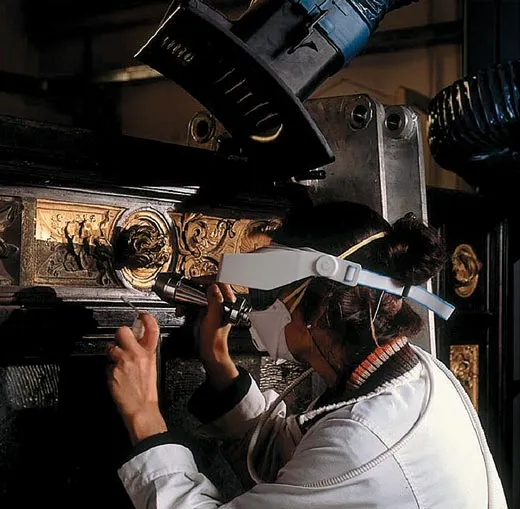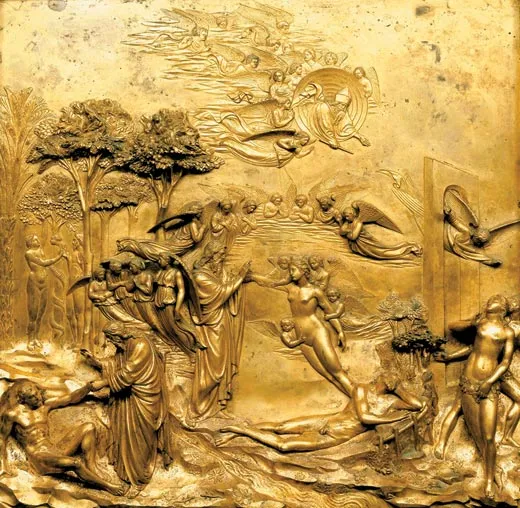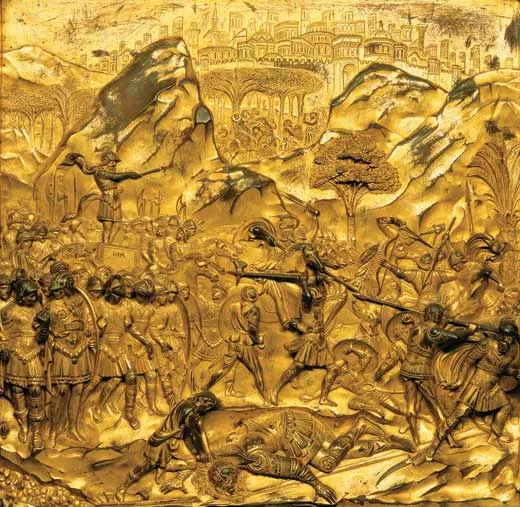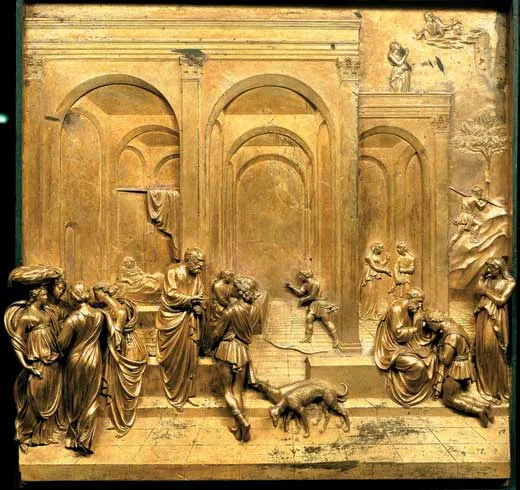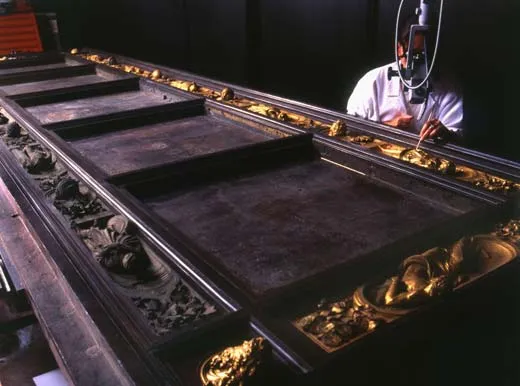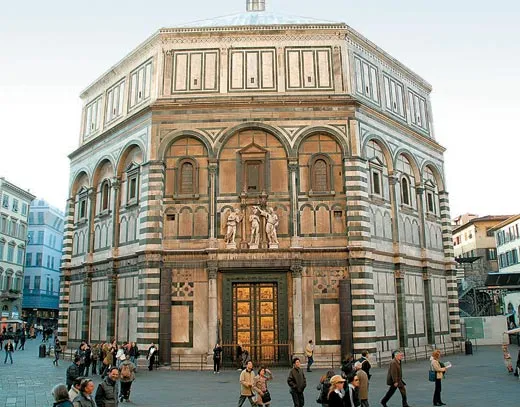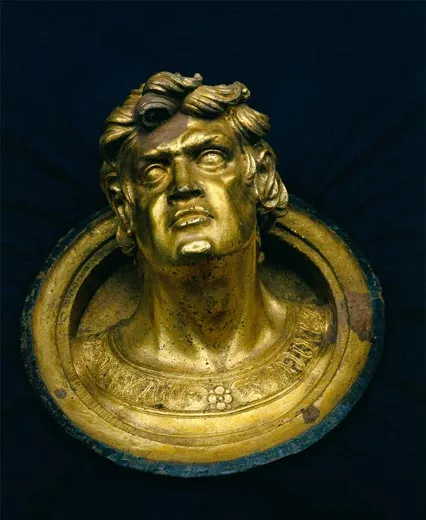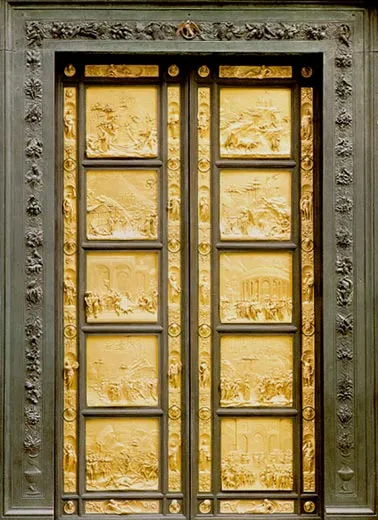The Gates of Paradise
Panels from the Italian Renaissance sculptor Lorenzo Ghiberti tour the U.S. for the first time
Michelangelo likened the gilded bronze doors of Florence's Baptistery of San Giovanni to the "Gates of Paradise." The phrase stuck, for reasons that anyone who has seen them will understand. Combining a goldsmith's delicacy with a foundryman's bravura, sculptor Lorenzo Ghiberti condensed the Old Testament into ten panels to produce one of the defining masterpieces of the Italian Renaissance. Since their installation in 1452, the doors have withstood a variety of near-biblical catastrophes: a torrential flood, vandalism, overzealous polishing and caustic air pollution. When the doors were finally removed for restoration from the facade of the 11th-century octagonal Baptistery in 1990, they looked dull and grimy. But the worst damage was occurring almost invisibly. Diagnostic studies revealed that fluctuations in humidity were causing unstable oxides on the bronze beneath the gilding to dissolve and recrystallize, creating minute craters and blisters on the gold surface.
A disastrous Arno River flood in 1966 had knocked five panels off the door frames and left another hanging loose. (A conservator later drilled holes in the panel backs to reattach them with screws.) The restorers' first task was to clean the six panels, successively bathing them in a Rochelle salt solution and water, then applying acetone and drying them with warm air. "It was a great surprise when we took the first panel out and saw how much gold was there and how shiny it was," says Stefania Agnoletti, the conservator in charge of the cleaning. "It was an emotional moment."
After laboriously removing the four additional panels and some of the other firmly embedded gilded elements, the conservators decided it was too risky to continue. To clean the gilded elements still attached, the team adapted laser techniques that they had used successfully to clean stone statues. The drawback of lasers is their tendency to heat surfaces, which would harm the gilding. But scientists in Florence developed one that could beam a more intense ray for a shorter time, and in 2000, the conservators began using it on the doors' gilded sculptures. For ungilded portions, they employed an array of tools that resemble a dentist's arsenal: a small scalpel for thick encrustations, a drill for precise excisions and a little rotating brush for polishing. They hope to finish the work in 2008.
To celebrate the nearly completed restoration, three of the ten panels (and four of the doors' smaller sculptural pieces) are now touring the United States as part of an exhibition organized by the High Museum of Art in Atlanta. The show, which opened there and traveled to the Art Institute of Chicago, will go on to the Metropolitan Museum of Art in New York (Oct. 30-Jan. 14, 2008) and end at the Seattle Art Museum (Jan. 26-April 6, 2008). Then the sculptures will return to Florence to be reattached to the door frames and encased in a plate-glass box, into which inert nitrogen will be pumped to prevent future oxidation. The restored doors will be displayed in the city's Museo dell'Opera di Santa Maria del Fiore. A shiny replica, installed in 1990, will remain at the Baptistery itself.
Ghiberti's doors were instantly recognized as a masterpiece. As one commentator declared in the 1470s, "nothing like them had been done before on the globe and through them the name of man shines everywhere." The three panels selected for the U.S. tour—"Adam and Eve," "Jacob and Esau" and "David"—show why. By combining several biblical episodes into a single frame in "Adam and Eve," Ghiberti demonstrated his command of high and low relief and introduced a narrative technique new in sculpture—the simultaneous depiction of successive scenes. And with his portrayal in "David" of a pitched battle and a triumphal procession, the artist showed a flair for evoking large crowds within a small area.
The third panel, "Jacob and Esau," is Ghiberti's most masterful. "It best demonstrates his genius," says Syracuse University professor Gary Radke, the curator of the exhibition, because "it shows so many aspects of Renaissance art." The receding tiles of the floor illustrate the recent innovation of scientific perspective, and the arches and pilasters are inspired by Roman architecture as interpreted in Filippo Brunelleschi's spare, monumental churches. (Brunelleschi is renowned as the architect of the dome of Florence's Cathedral of Santa Maria del Fiore, known more familiarly as the Duomo.) Ghiberti also played here with sculptural illusion by extending some of his figures almost off the panel, while depicting others in low relief. The artist apparently shared posterity's high regard for this achievement. "Ghiberti put his own self-portrait and his signature right under it," Radke notes. The self-portrait bust shows a bald man of about 60, with a shrewd gaze and a thin, broad mouth that seems to be smiling with self-satisfaction.
Perhaps because Ghiberti was no radical, his standing has long been subordinated to those of his contemporaries—especially Brunelleschi and the sculptor Donatello—who appeared to depart more dramatically from medieval traditions. But the view of Ghiberti as a conservative is a misconception; though he retained an allegiance to the restraint and balance of medieval art, he innovatively used physical movements and individual features to reveal mood and character. "He's got both feet in both worlds," says Radke. "You can see him develop new ways to be more expressive and illusionistic, and to include bigger crowds and lots more effects, but he doesn't do it in a wildly revolutionary way. He has a real talent for presenting novelty so that it seems to come out of the recent past."
Ghiberti apprenticed in childhood to goldsmith Bartolo di Michele, who was his stepfather or, possibly, his father. His mother, Mona Fiore, the daughter of a farm laborer, had made what seemed an advantageous marriage in 1370 to Cione Ghiberti, the son of a notary, but, after a few years, left him for Bartolo, with whom she lived in a common-law marriage. (After Cione's death in 1406, they wed.) The facts of Lorenzo's paternity remain in dispute, but in any case the young man was raised as a goldsmith's son and showed a precocious aptitude for the craft.
In 1401, Bartolo informed Ghiberti, who had left Florence during a brief outbreak of the plague, that the Baptistery in Florence was commissioning a second set of bronze doors. The first set, produced by Andrea Pisano 70 years before, was a widely recognized triumph of bronze casting; the new commission would be the most important in Florence since Pisano's. According to Giorgio Vasari's 16th-century Lives of the Artists, Bartolo advised Ghiberti that "this was an opportunity to make himself known and to show his skill, besides the fact that he would make such a profit from it that neither would ever again have to work on pear-shaped earrings."
The competition was organized by the Calimala, a guild of wealthy wool-cloth merchants who supervised the decoration of the Baptistery. Seven finalists, including Ghiberti, worked for a year to depict in bronze the story of Abraham's call to sacrifice his son Isaac. In the end, it came down to two artists, Ghiberti and Brunelleschi. As can be seen in their rival entries (opposite), Brunelleschi's version emphasizes the violence, while Ghiberti devised a calmer, more lyrical composition.
To our eyes, the Brunelleschi seems more powerful and "modern." But Brunelleschi's determination to cram as many attention-grabbing devices into one work may have seemed willful to 15th-century Florentine jurors. Certainly, Ghiberti's craftmanship was superior; unlike Brunelleschi, who soldered his panel from many separate pieces of bronze, Ghiberti cast his in just two, and he used only two-thirds as much metal—a not-inconsiderable savings.
The combination of craft and parsimony would have appealed to the practical-minded men of the Calimala. By his own account, Ghiberti won the competition outright; but Brunelleschi's first biographer says that the jury asked the two men to collaborate and Brunelleschi refused. In any event, in cooperation with Bartolo (Ghiberti, only about 20, was still too young to be a member of a trade guild and required a co-signer) and a distinguished studio of assistants that included Donatello, Ghiberti took on the job. It would occupy him for the next two decades.
During those years, Ghiberti also found time to start a family. He married Marsilia, the 16-year-old daughter of a wool carder, and soon after, she gave birth to two sons, Vittorio and Tommaso, in 1417 and 1418, respectively. Both became goldsmiths and went to work in their father's studio, but only Vittorio—who took over the business upon his father's death in 1455—stayed with the thriving firm.
Thanks to the acclaim that greeted the doors upon their completion, Ghiberti was assigned another set for the Baptistery. It is on this work—the Gates of Paradise—that his reputation rests today. In what is considered to be the first autobiography by a European artist, known as I Commentarii, Ghiberti recalled the creation of what he rightly judged to be "the most outstanding" of all his works. For the assignment, he wrote, he was "given a free hand to execute it in whatever way I thought it would turn out most perfect and most ornate and richest." With that mandate, he dispensed with traditional quatrefoils—four-lobed configurations—and instead divided the doors into ten square panels, which he surrounded with 24 figures and 24 heads. It took him 12 years to model and cast the main reliefs and another 15 to finish them. Not so much time, really, when you consider that along with the arduous work of detailing the surface of the cast bronze—the punching, hammering, incising and polishing that, collectively, is known as "chasing"—he had to come up with a new syntax for portraying a narrative.
From the first panel, set in the Garden of Eden (page 71, top), he exhibited an exuberant self-confidence with a story line that starts on the left in high relief with God animating Adam, then moves to a central scene of God creating Eve from the rib of a recumbent Adam, and ends on the right with the expulsion of Adam and Eve. Incised in low relief in the rear is the back story: the temptation of Adam and Eve by the serpent. "Up to the Gates of Paradise, the convention was to depict one episode per sculpture," Radke says. "It was Ghiberti's great inspiration that you could have a multiple narrative in these square windows, and that would enliven the work."
The response to the completed doors was nothing less than rapturous—so much so that Ghiberti's earlier doors were moved to allow the new ones to go in the most prominent position, on the east, facing the Duomo. There they would be one of the major artistic attractions of the city for more than five centuries.
One of the scholarly bonuses of the restoration is the new insight provided into Ghiberti's work methods. Not until the panels were removed did conservators realize that Ghiberti had cast each of the two doors, including the frames, as a single three-ton bronze piece. "Before him, nobody in Italy was able to create something in bronze so big in dimension, not since the end of the Roman Empire," says Annamaria Giusti, the director of the Museo dell'Opificio delle Pietre Dure, which is overseeing the restoration. It remains a mystery how Ghiberti learned the technique. He did not discuss it in his autobiography. "He loved to present himself as a self-made artist," she observes.
Indeed, his doors arguably afford more insight than his writings into Ghiberti's slyly playful personality. In the temptation scene in the "Adam and Eve" panel, for example, Ghiberti imported a symbol of wisdom from Roman mythology—Minerva's owl—and placed it in the apple tree. Riffing wittily in "Jacob and Esau" on the story of how the smooth-skinned Jacob impersonated his hairy brother to dupe their blind father, Ghiberti placed a pair of dogs in the foreground: one is chased with wavy lines to mimic Jacob's fleece covering, and the other is left perfectly smooth. Then there is the fascinating "Joshua" panel, which remains in Florence. To portray the crumbling of Jericho's walls before Joshua's army, Ghiberti incised deep cracks in the fortifications. Cracks! Along with holes, cracks would be the bronze artist's greatest fear. Only a man like Ghiberti, who rose immediately to the summit of his profession and stayed there, would be so insouciant as to simulate dreaded cracks in his bronze casting.
Arthur Lubow lives in Manhattan and writes frequently on the arts. His article on American artists in Paris ran in January.

